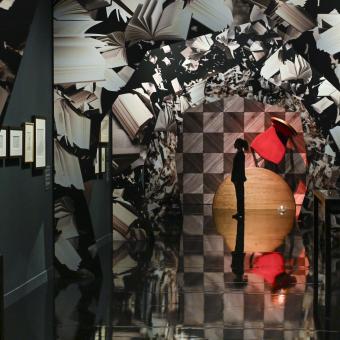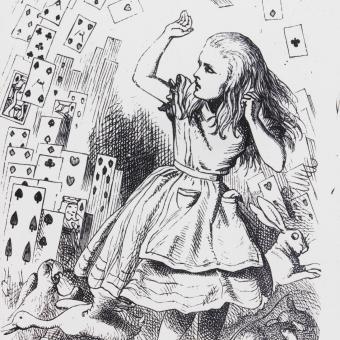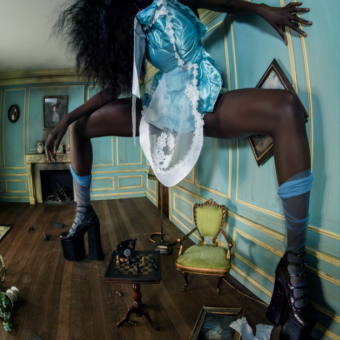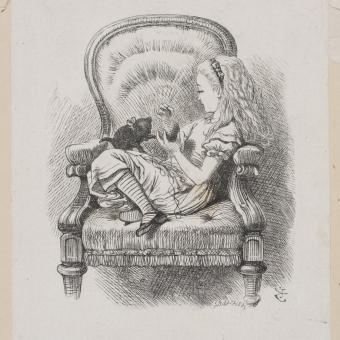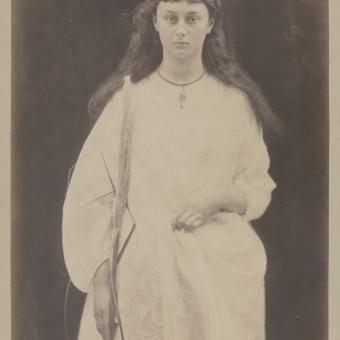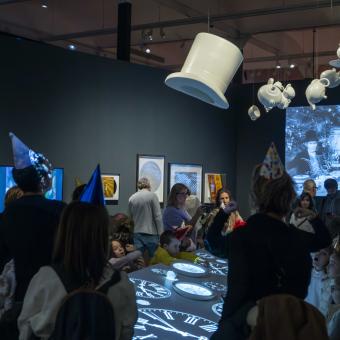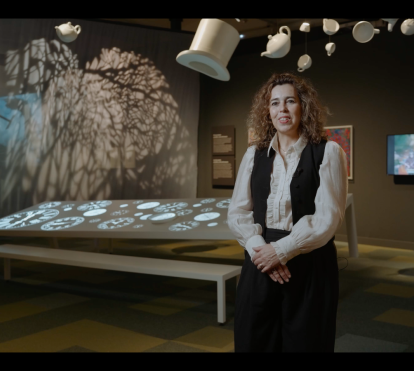
CaixaForum Barcelona surrenders to Alice with an exhibition dedicated to this modern heroine
17.10.24
11 minutes readThe Worlds of Alice. Dreaming of Wonderland proposes a dreamlike journey to the origins, adaptations and artistic reinventions of Alice in Wonderland through time and various disciplines up to the present day.
The director of CaixaForum Barcelona, Mireia Domingo, and the senior curator of Theatre and Performance of the Victoria & Albert Museum in London, Kate Bailey, presented The Worlds of Alice. Dreaming of Wonderland this Thursday, the first and most comprehensive exhibition on the cultural phenomenon generated by this modern heroine. Through 312 objects and works of art, this exhibition offers a broad perspective of the influence of the two books featuring this rebellious heroine, nearly 160 years after her creation.
In collaboration with the Victoria and Albert Museum, the exhibition offers a broad overview of the impact and influence of this Victorian work, a cultural phenomenon in terms of its scope and a source of inspiration for the most creative minds. Its protagonist, Alice, is a modern heroine, a rebel driven by curiosity and defiance of logic, who bravely confronts a world as fantastical as it is absurd.
Like the book, the exhibition aims to be a celebration of almost 160 years of creativity and curiosity through different art forms that have been inspired by the fantasy universe of Alice through literature, film, photography, visual arts, design, fashion, science and theatre.


All of this is showcased through the art and design collections of the Victoria & Albert Museum, whose founding (in 1852) coincides with the publication of Alice during the height of the Victorian era.
Why is Alice still relevant
today?

Written in 1865, Alice’s Adventures in Wonderland has never gone out of print and has been translated into more than 170 languages. It forms part of the collective imagination, and the exhibition offers various answers as to why a Victorian character remains so significant. The culture that gave rise to his writing and how the themes and ideas it presents continue to be relevant today are also the subject of analysis. One of the questions posed by the exhibition is why this character pushes us to be more creative, to be more curious, and also to question established norms.
Through an immersive and surprising staging by the set designer and playwright Ignasi Cristià, who works on museographic and theatrical projects, the exhibition invites visitors to play the game of becoming Alice and follow her journey in the texts. The museography of the space plays with changes of scale, colour, settings and shapes in the various halls, taking visitors on a journey between the real and the imaginary. Iconic scenes will unfold one after the other, such as the fall down the rabbit hole, the Mad Hatter’s tea party, the Pool of Tears and the Queen of Hearts’ playing cards, and many others. The aim is to transport visitors of all ages to different fantasy spaces through time, space, play and reflection.
The exhibition follows the narrative structure of the 12 chapters of Alice in Wonderland, and is divided into five thematic sections:
- “The Invention of Alice”
- “Through the Screen”
- “Alice, Gateway to Other
Worlds”
- “Alice on Stage”
- “Becoming Alice”
The exhibition includes a playful dimension and a space for reflection that helps establish a personal dialogue between the world of Alice and the one we inhabit. Visitors are asked if Alice’s world is really so strange, and are challenged with questions about whether they have ever felt like the protagonist, drowning in a sea of tears.
A
rabbit hole welcomes the visitors

At the start of the exhibition, visitors will descend down the rabbit hole in a visual display full of books, which then connects to a new setting emulating a Victorian library. This first section delves into the literary, social and political background and context surrounding the creation of Alice’s Adventures in Wonderland and its sequel by Lewis Carroll, a Victorian scholar who was a photographer, mathematician and writer.
Alice’s adventures began as an imaginary story that Carroll narrated to Alice Liddell and her sisters over the course of one “golden afternoon” in 1862. What initially seemed like a children’s tale ended up becoming an expression of universal themes that addressed aspects of the culture, politics and scientific knowledge of the time. In creating the story, he drew inspiration from his own life, his studies at the University of Oxford and the world around him. The Alice books reflect a changing society and a transformative era marked by industrialisation and globalisation.
In this first section, entitled The Invention of Alice, visitors can see images of the Christ Church Library in Oxford, whose spaces have also served as inspiration for the Harry Potter saga, as well as photographs, puzzles, logic games and objects reflecting a fascination with the world and nature, to transport visitors into the imagination and universe of the creator.
There are also sketches by the author himself, as well as some drawings of the illustrations that John Tenniel created for the publication of the book, reflecting the early creative processes. These drawings bring to life some of the main characters in the stories, such as the White Rabbit, the Queen of Hearts, the anthropomorphic egg Humpty Dumpty, as well as the main character, originally depicted with dark hair both in the initial illustrations and in the reality of Alice Lidell. It was that transformed the little girl into a blonde. First editions of these books can also be seen in this section, such as the first publication of the novel in Spain, with a Catalan translation by Josep Carner containing illustrations by Lola Anglada, from 1927.

In the transition from the first section to the second, a projection recalls Alice’s Pool of Tears. The second section, Through the Screen, reflects how the story quickly became popular with filmmakers. In the early 20th century, cinema began to emerge as the main form of popular entertainment, and this new medium allowed Alice to reach a wider, more global audience.
Film studios recognised the commercial potential in Carroll’s story: witty yet familiar, it allowed for the showcasing of nascent film technologies, as well as extravagant costumes and fascinating sets. Adaptations of the Alice books for the big screen have resulted in some of the most spectacular sequences in the history of cinema, featuring everything from primitive editing tricks to computer-generated imagery in the 21st century.
Alice’s transition to the screen has had a decisive influence on the way in which we see or imagine the girl herself, as well as on the dissemination of her adventures worldwide. Her iconic appearance, now recognisable all over the world, originates from cinema, which has fuelled her myth and permanently embedded it in popular imagination.
This section recovers the first film adaptation of Alice, directed by Cecil Hepworth and Percy Stow, which dates back to 1903, just five years after Lewis Carroll’s death. With its ten minutes of footage, it was the longest film ever produced in Britain at the time. Innovative trickery was used to resolve scenes like the passage in which Alice shrinks. According to one of the directors, they tried to adapt the story “with all the precision at our disposal and with reverential fidelity, as far as possible, to Tenniel’s famous illustrations”.
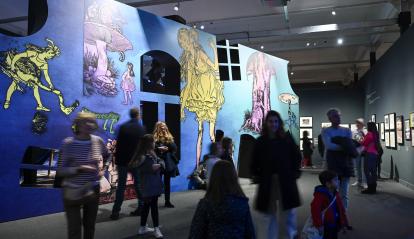
Disney: the consolidation of an icon
After several films, it was Disney who cemented this icon with the film that has had the greatest cultural impact on the consciousness of multiple generations since its release in 1951. Walt Disney had always been interested in the Alice books and began planning a feature film as early as the 1930s, and the Hollywood director’s friendship with Salvador Dalí enhanced the surrealist content of the film’s imagery. This section also features the film by director Tim Burton, released in 2010, which presents a very empowered Alice.
Outside the realm of commercial cinema, several filmmakers have brought new creative visions to the Alice books, in many cases departing almost entirely from the original text and illustrations. Under the gaze of more experimental creators, Carroll’s stories reveal the potential of the mythology underlying the Alice books as a source of psychological study and artistic experimentation. Among them, names such as the Czech director Jan Svankmajer, as well as the productions by the Argentinean Eduardo Plá in 1976, and the Catalan Jordi Feliu, in 1978, stand out. In Alicia en la España de las Maravillas (Alice in Spanish Wonderland), Feliu takes Alice to 1940s Spain to depict a specific moment in the history of Catalonia under Franco’s dictatorship and repression.
Distortion, psychedelia and perception
The third section, Alice, Gateway to Other Worlds, focuses on the influence of Alice on artistic creation, music and popular culture: on the one hand, with the emergence of surrealism in the 1920s; and on the other, the decade of the 1960s, with all the transformations it brought.

The darker themes of Wonderland and its journey into the unconscious seduced many artists associated with surrealism. The rich material provided by Carroll’s fantastical world helped them in their explorations into the world of dreams, the distortion of perception and the crossovers between reality and fiction. Later, in 1965, the centenary of the first publication of Alice’s Adventures in Wonderland coincided with a renewed interest in the Victorian period and the opportunity to analyse the original books from a new era. New experimental artists tapped into the fascination with all things Wonderland, as the anarchic chaos of those books resonated well with the rebellious spirit of the 1960s. At the same time, characters like a talking rabbit, a grinning cat or a pipe-smoking caterpillar seemed to appeal directly to the psychedelic movement.
For visual artists, musicians, filmmakers and other creators, the way Alice questions the line between perception and reality, as well as her growing sense of self-determination and defiance, made her an anti-authoritarian symbol of the counterculture.
Works of art by Salvador Dalí and Max
Ernst
The exhibition brings together works of art inspired by this story from artists of the stature of Salvador Dalí, Max Ernst, Yayoi Kusama, Aldous Huxley, as well as Peter Blake, Edward Burra, Marion Adnams, John Armstrong and Ralph Steadman, among others.
This section recreates the iconic scene of the Mad Hatter’s tea party, featuring a long table where cups, plates and teapots hover above visitors’ heads as if they were falling from the ceiling.
The fourth section, Alice on Stage, presents Alice as the origin of various performance genres, in which Wonderland is a space for imagination where anything is possible.

This section highlights how Alice’s story continues to be a source of inspiration for numerous “scenes”, from theatre, music and dance to parody and political satire, even extending to the parallel stage of virtual reality. Since reality sometimes exceeds the limits of the imaginable, no metaphor seems as powerful as that of a wonderland where nonsense takes control.
It also shows how the concept of “wonderland” can traverse various genres, presenting the story as a timeless political text that facilitates critique and satire in multiple ways. Examples of this include the play Alice in Thunderland, first performed in 1944, Martin Rowson’s illustration Alice in Sunderland, for The Guardian, commenting on Brexit, or other examples where the books have been used as a metaphor to understand the political crises of recent years.
In addition, this section features some futuristic and purpose-made costumes specifically designed for the White Rabbit and Alice for a production at the National Theatre in London in 2015 and the Royal Opera House in London in 2011.

Finally, in Becoming Alice, the exhibition focuses on contemporary readings that present the character as a modern-day Alice, an explorer equipped for the 21st century. “Nowadays, everyone can identify with this text and can follow the mantra of curiosity and continuous learning,” explains the exhibition curator Kate Bailey.
This section presents contemporary fashion inspired by the characters from the book and created by international designers, some examples of which have appeared in Vogue and in catwalk shows, reinterpreting these costumes and bringing them into 21st-century fashion. It also addresses multiple identities that take Alice as a starting point, especially in anime comics and album covers of rock and pop bands.
Notable here is a selection of fashion photographs by Tim Walker and stylings by Edward Enninful in which different black models.
For the curator, Alice is also a state of mind and an agent of change: “There’s something very empowering about the story of a little girl making a difference, speaking truth to power.”
Just as a rabbit hole welcomes visitors, this section speaks of reinvention and transformation, inviting visitors to become their own version of Alice.
